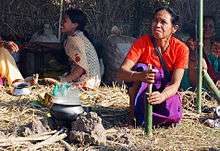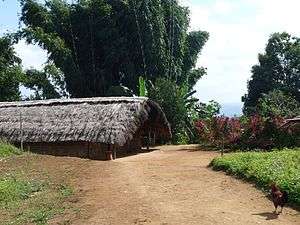Tiwa (Lalung)
Tiwa (Lalung) is an indigenous community inhabiting the states of Assam and Meghalaya (main region) and also found in some parts of Arunachal Pradesh, Manipur and Nagaland in Northeast India. They are recognized as a Scheduled tribe within the State of Assam. They were known as Lalungs in the Assamese Buranjis, Colonial literature[2][3] and in the Constitution of India, though members of the group prefer to call themselves Tiwa (meaning "the people who were lifted from below"). Some of their neighbors still call them Lalung.
| Total population | |
|---|---|
| 200,915[1] (2011 Census) | |
| Regions with significant populations | |
| Languages | |
| Tiwa minority, Assamese majority | |
| Religion | |
| Hinduism, Christianity |
A striking peculiarity of the Tiwa is their division into two sub-groups, Hill Tiwa and Plains Tiwas, displaying contrasting cultural features.
Origin
According to late Bishnu Prasad Rabha, the Tiwas are originally the Patorgoyan clan of the Chutiyas (now officially Tiwas and Chutiyas are two separate communities of North East, India). He said that the word "Chutiya" became "Tiya/Tiwa" by omitting the first part "Chu". The Patorgoyan clan is no more found among Chutia, and are believed to have migrated to the west. The Ahoms upon their arrival in Assam also called the Chutiyas as "Tiura". Dalton has also remarked that the tribe called "Tiwa" are of the same family and the "Lalungs" of Upper Assam claim to be of Chutiya descent. Surnames like Pator (chiefs), Dewri (priests), Bhuyan (landlords), Bordoloi (councilor), Borah (minister) all have roots in the Chutiya kingdom. The origin of the word "Lalung" hasn't yet been decided by the historians. In the Karbi language, "Lalung" means "sinking from the water", while in the Tai language (Ahom), it means "migration towards the west". From this, it can be presumed that the Tiwa people first met the Karbis when they proceeded towards the west to Nagaon by crossing the Brahmaputra.
This is moreover supported by the folklore of the Tiwa people who believe that they migrated a long time back from their homeland which was situated in the eastern part of undivided Darrang district (Sonitpur district). The memory of their original homeland is expressed in their popular song "Lali-lai-Hilali". This folklore of Hilali is also shared by the Sadiyal Kacharis (i.e. Sonowals, Chutiyas, Deoris) which points out to the fact that the entire area including the hills of Arunachal, and the present-day districts of Sonitpur, Lakhimpur, Dhemaji, Tinsukia, Dibrugarh, Sibsagar was once a single kingdom which was bounded by the Dikarai and Dikhou.
Researchers like Robert Shafer, George Greirson and Dr. Suniti Chatterjee have all placed the Tiwa, Kokborok and the Chutiya language as belonging to a single family under Kachari languages. In the 'Assam Census report, 1881' Wadell makes a significant proposition about the Tiwas, "The Lalungs got mixed up with the Garos and the Mikirs. They have numerous exogamous clans". This could be one of the reasons as to why the Ahom chroniclers could not differentiate between the Tiwas and the other tribes of the hills, and the reason why the Tiwas developed a unique culture of their own retaining old customs from their homeland as well as getting influenced from the Karbis and Garos.
Later period
The Buranjis (Assamese chronicles) recount the meeting of Assamese soldiers with "people of the margins"(datiyaliya) and the settlement of 12 families of Lalung and Mikir, i.e. Tiwas and Karbis, in the plains in the 17th century.[4] Tiwa people are closely associated with the principality of Gobha.[5] The Gobha raja belongs to a Tiwa clan and his territory covers more or less the Tiwa cultural realm. Gobha is mentioned in the Buranjis since the early 18th century, as an important market for the trade between Tiwa (Lalung) Kingdom of greater Assam, and the Jaintia Kingdom.[6] These two powerful neighbors have since been competing to keep Gobha principality under their authority, with varying success. The historical role of Gobha and the Tiwas as mediators between plains and hills in Central Assam is enacted every year during an old fair, the Jonbeel mela.
Hill Tiwas
The Hill Tiwas live in the westernmost areas of "The Ancient Lalung - Tiwa Hills" now known as Umswai of Amri block in West Karbi Anglong district (Assam) and as well as in the Northeastern corner of Ri-Bhoi district (Meghalaya). They speak a Tibeto-Burman language of the Bodo-Garo group. They are divided into a dozen clans recognized by specific names which they use as patronymics. Their descent system can be said to be ambilineal.[7] In most cases, the husband goes to live in her wife's family settlement (matrilocality), and their children are included in their mother's clan. However, in about 30% of unions, the woman comes to live with her husband. In such cases, children take the name of their father. This trend is on the rise under the influence of neighbouring populations which are mostly patrilineal. About one-half of Hill Tiwas follow their "traditional" religion. It is based on the worship of local deities. The other half has been converted to Christianity since the 1950s. The Hill Tiwas society is organized around seven old villages which constitute its political as well as ritual center. Each of them harbors a chief (loro) who performs judicial and religious duties for a network of settlements. Old villages are also characterized by their bachelor dormitory (shamadi).

Plains Tiwas
Plains Tiwas live on the flatlands of the Southern bank of the Brahmaputra valley, The following places below are the areas mostly in Morigaon, Nagaon, Hojai, Kamrup (Rural) and (Metro), Sibsagar, Jorhat, Sonitpur, Lakhimpur and Dhemaji districts. The vast majority speak Assamese as their mother tongue, Tiwa language is still spoken on the foothills and in rare villages of the plains. Their descent system is definitely patrilineal. Their patronymics are not derived from their clan's names but are common Assamese and plain Tiwas ethnic surname-names instead (mostly Lalung, Pator, Senapati, Manta, Dekaraja, Dewraja, Bordoloi, Konwar, Doloi, Kakoti, Deka, Dewri, Deuri, Deory, Deori, Bhuyan, etc.). Their religion shares many elements with Assamese Hinduism but remains specific.
Tiwa clan system
The Tiwa community is divided into several Phoit (Wali) and Dilok (divided into exogamous clans and again the clans are sub-divided into many sub-clans) Example - Amsai wali, Marjong wali, Magro, Sagra, Mayong, Lingra, Lumphui, Amkha, Amlera, Amni baro, Amnisa, Rongkhoi baro, Rongkhoisa. The Wali or Phoits have their own own Loro. The 'Loro' (priest) is the Governor of the 12 Phoits or Wali kingdoms. Now in every Phoits there is a Sat Phuni, Baro Phuni called Khul, Pongos, Khel, Mahar, and Warang. Tiwa have various Khuls, they can marry with other Khul but not with Pongos, Khel, and Warang (means that they are allowed to marry people from other clans). A single khul consists of several Khel Mahar. In every Khul there are different Khel called Warang.
Note: Khul = Clan, (i) Pongos, (a) Khel, Warang
The Tiwa clans cooperate with one another as a community, whether constructing a house, harvesting rice, or worshiping. Every clan has its own place of community worship where there is a titular for the clan's god.
The List of clans of the Tiwa (Lalung):
1. Agari (আগাৰি), 2. Amphi (আমফি), 3. Amphili (আমফিলি), 4. Amchi/Amsi (আমচি), 5. Amchong/Amsong (আমচং), 6. Aphi (আফি), 7. Agar (আগাৰ), 8. Amji (আমজি), 9. Akawang (আকৱাং), 10. Anchong/Ansong (আনচং), 11. Buma/Puma (বেমা/পেমা), 12. Borong (বৰং), 13. Chagra/Sagra (চাগ্ৰা), 14. Cholong/Solong (চলং), 15. Chomsol/Somsol (চমচল), 16. Chongrang/Songrang (চংৰাং), 17. Chomchong/Somsong (চমচং), 18. Chomcha/Somsa (চমচ'), 19. Chongcha/Songsa (চংচ'), 20. Chanchor/Sansor (চস্ঞ্চৰ), 21. Cholo/Solo (চল'), 22. Darang (দৰং), 23. Darphang (দাৰফাং), 24. Daphor (দাফৰ), 25. Dakhor (দাখৰ), 26. Datrang (দাত্ৰাং), 27. Dongkhoi (দংখৈ), 28. Damo (দাম'), 29. Dumura (দুমুৰা), 30. Hukai (হুকাই), 31. Khorai/Kharai (খৰৈ/খৰাই), 32. Kholar (খলাৰ), 33. Khajar/Khachar/Khasar (খাজাৰ/খাচাৰ), 34. Karkha (কাৰখ'), 35. Kharal (খাৰাল), 36. Khamli (খামলি), 37. Khonjai (খনজাই), 38. Kocho/Koso (কচে'), 39. Lumphoi (লুম্ফৈ), 40. Ladur (লাদুৰ), 41. Laram/Lara (লৰম/লৰ), 42. Lupu (লুপু), 43. Madar/Mathar (মাদাৰ/মাথাৰ), 44. Madur (মাদুৰ), 45. Magor (মাগৰ), 46. Marjong (মার্জং), 47. Malang/Melang (মালাং/মেলাং), 48. Machlai/Maslai (মাচলাই), 49. Markang (মার্কাং), 50. Machereng/Masereng (মাচেৰেং), 51. Mithi (মিথি), 52. Maloi (মালৈ), 53. Muni (মুনি), DEWRI (দেউৰী) 54. Mathlai (মাথলাই), 55. Mothrong/Mosrong (মথৰং/মচৰং), 56. Phangchong/Pamchong/Phangsong/Phamsong (ফাংচং/পামচং), 57. Pulu (পুলু), 58. Puru/Pu (পুৰু/পো), 59. Radu (ৰাদু), 60. Rongkhoi (ৰংখই), 61. Taram (তৰম).
Tiwa festivals
Festivals constitute a significant part of the culture of the Tiwa people. There are many festivals of Tiwa tribes. Tiwa people celebrate several occasions and festivals. The main festivals of the Tiwa tribes are: Three Pisu (Bihu), Borot utsav, Sogra puja, Wanshuwa, Jonbeel Mela, Kabla, Langkhon Puja, Yangli Puja, etc. Tiwas celebrate Christmas, New Year, and Easter. They consider Christmas the best. In the festivals, the Tiwa communities sing two types of songs. These are:
1) Lo Ho La Hai - songs of the ceremony of name giving, wedding and harvesting, etc.
2) Lali Hilali Lai– song of the marriage ceremony, Karam and similar festivals.
- Songs and dances are the life spirit of the Tiwa community; the tribe is considered to have one of the richest reservoirs of folk songs and dances in the state of Assam and Meghalaya.
Population

Tiwa population in India is 371,000 approx. (2011 census). But according to the 2001 Census reports 161,000 approx. "Tiwas/Lalungs"; this figure comprises only the Plains Tiwas. As they became a Scheduled Tribe after the 2001 Census, the Hill Tiwas were not taken into account. Their population may be estimated at around 10,000 approx. The total number of Tiwa speakers amounts only to 34, 800 approx. (2011 Census).[8]
Official status
Tiwas, under the denomination of "Lalung", have been recorded as a Scheduled Tribe since the first Constitution Order (1950) for the State of Assam "excluding the autonomous districts of Karbi Anglong and North Cachar Hills (now named Dima Hasao)", thus leaving the Hill Tiwas out. It was only in 2002 that the Lalung ST status has been extended to Karbi-Anglong district and thus to the Hill Tiwas. Tiwas still do not benefit the ST status in the State of Meghalaya.
See also
Notes
- "A-11 Individual Scheduled Tribe Primary Census Abstract Data and its Appendix". www.censusindia.gov.in. Office of the Registrar General & Census Commissioner, India. Retrieved 3 November 2017.
- Bhuyan S.K. (ed.) Deodhai Asam Buranji. Gauhati: DHAS, 1932.
- Hunter W. A statistical account of Assam. London: Trubner, 1879.
- Bhuyan S.K. (ed.) Deodhai Asam Buranji. Gauhati: DHAS, 1932.
- Ramirez, 2014
- Bhuyan S.K. (ed.) Deodhai Asam Buranji. Gauhati: DHAS, 1932; p.35.
- Ramirez, Philippe, People of the Margins, Spectrum, 2014
- The Joshua Project lists the Tiwa population as 348,000 with no quoted reference. This figure seems largely over-estimated Joshua Project entry on Tiwa
| Wikimedia Commons has media related to Tiwa people. |
.jpg)